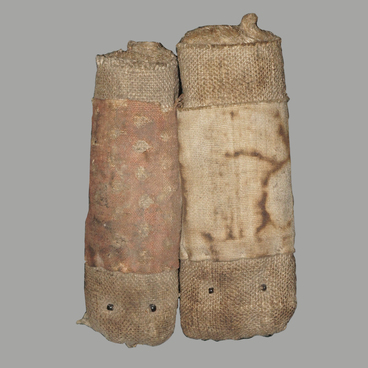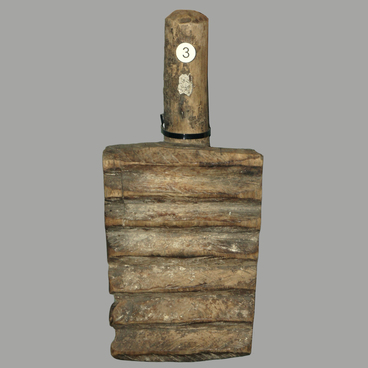Shalyg is a Shor cult object It is a flat anthropomorphic figure carved from wood. It has a round head with a polygonal knob at the top. The nose is long, straight, the eyebrows come from the upper edge of the nose at an acute angle. The eyes are of triangular form. The belly line is convex, oval, it is cut from the lower edge of the nose along the whole length of the figure. Hands come down to the middle of the torso and have with rounded extremities. There’s a semi-oval notch between the legs. The feet are not outlined, one leg is shorter than the other. The length of the object is about 44 cm. It was brought to the museum in the mid-1920s by Kuznetsk ethnographist Georgy Stepanovich Blynskiy from the Mountain Shoria region.
Shalyg was venerated as the hunting spirit and the patron of hunting. During the year it was kept in a barn, before starting a big hunt it was brought into a yurt and offerings were brought to it: a bowl of tolqan (barley flour with milk), and the figure itself was sprinkled with araka (home-distilled alcoholic drink). Lack of respect for or carelessness towards shalyg threatened, it was believed, with a failure on the hunting field. Besides, such a careless hunter started to have pains in the bones and other misfortunes. According to the Shorts, there was only one way to get rid of it - to make a sacrifice to shalyg, i.e. to feed shalyg with tolqan.
Big hunt is an important event in the life of the entire Shor kinship (seok or söök). Its results influenced the wellbeing of all the relatives without exception. The period of the big hunt usually started in November as the big snow came. Men hunters would gather in groups and go into the taiga to hunt animals. Sprinkling shalyg with araka (home-distilled alcoholic drink) is only one of the numerous rituals of the Shors associated with this action.
The Shors actually remained pagans, shamanists in their beliefs until the beginning of the 19th century. A shaman they called kam played a big role in their life. Even after the adoption of Christianity, in everyday life at important events (whether it be a wedding or funeral, the beginning of the hunting season or a disease of a relative, etc.) the Shors have always asked the kam to influence a certain action in a beneficial way.
Shalyg was most venerated among the Shors of the middle reaches of the Kondoma River.
Shalyg was venerated as the hunting spirit and the patron of hunting. During the year it was kept in a barn, before starting a big hunt it was brought into a yurt and offerings were brought to it: a bowl of tolqan (barley flour with milk), and the figure itself was sprinkled with araka (home-distilled alcoholic drink). Lack of respect for or carelessness towards shalyg threatened, it was believed, with a failure on the hunting field. Besides, such a careless hunter started to have pains in the bones and other misfortunes. According to the Shorts, there was only one way to get rid of it - to make a sacrifice to shalyg, i.e. to feed shalyg with tolqan.
Big hunt is an important event in the life of the entire Shor kinship (seok or söök). Its results influenced the wellbeing of all the relatives without exception. The period of the big hunt usually started in November as the big snow came. Men hunters would gather in groups and go into the taiga to hunt animals. Sprinkling shalyg with araka (home-distilled alcoholic drink) is only one of the numerous rituals of the Shors associated with this action.
The Shors actually remained pagans, shamanists in their beliefs until the beginning of the 19th century. A shaman they called kam played a big role in their life. Even after the adoption of Christianity, in everyday life at important events (whether it be a wedding or funeral, the beginning of the hunting season or a disease of a relative, etc.) the Shors have always asked the kam to influence a certain action in a beneficial way.
Shalyg was most venerated among the Shors of the middle reaches of the Kondoma River.


